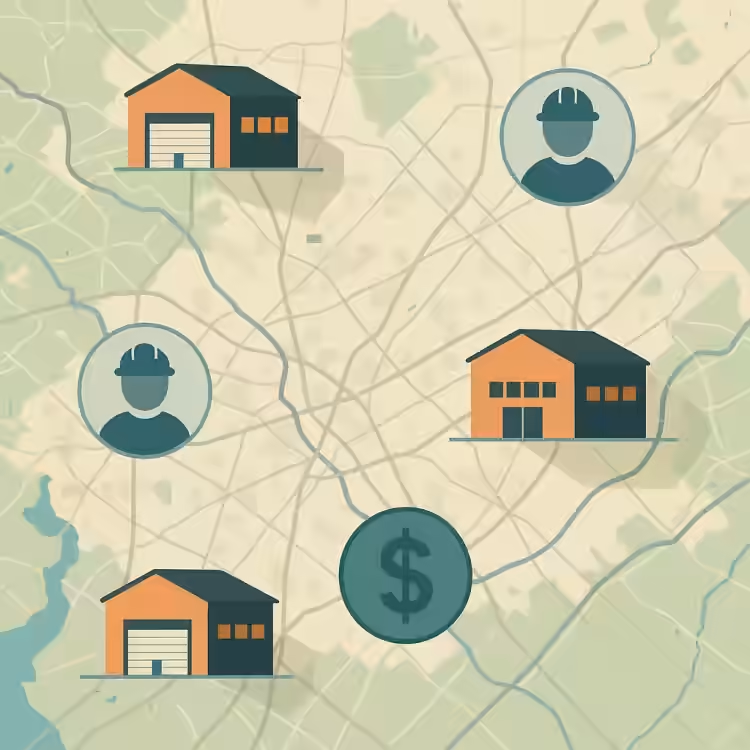How Labor Markets Affect Warehouse Location Choice
Labor Isn’t Just a Line Item
When companies look for warehouse space, they usually think about rent, square footage, and freeway access. All valid. But there’s one factor that can make or break your operation: the local labor market.
Does the area have enough workers? Are they reliable? Can you afford them? Are they trained?
If you pick the wrong market, you’ll spend more time recruiting than fulfilling orders. And that’s a losing game—especially during peak seasons.
So let’s dig into how labor trends affect warehouse site selection, and why you need to be thinking people before property.
Low Cost Doesn’t Mean High Value
Sure, you can find dirt-cheap industrial space in the middle of nowhere. But who’s going to work there?
Take a market like Topeka, Kansas. Industrial rents are low. But the available warehouse labor pool? Not so much.
On the flip side, a location like Phoenix, Arizona may have higher rents, but a larger, more accessible workforce. That labor pipeline is worth paying for if it keeps your fulfillment engine running.
So when comparing sites, don’t just look at cost per square foot. Look at the cost of unfilled jobs, the expense of overtime, and the pain of high turnover.
The Urban-Rural Tension
This one comes up all the time.
- Urban warehouses have the labor but face higher competition and wages.
- Rural warehouses have lower costs but struggle to staff up—especially during Q4 surges.
Many companies split the difference. They place distribution centers just outside the urban core—say 30 to 50 miles out—where land is cheaper, but labor is still accessible via major highways or transit.
Allentown, Pennsylvania is a textbook example. It’s not Philadelphia, but close enough to tap into that labor pool—and with dramatically lower rent.
Case Study: Memphis vs. Nashville
Both Tennessee cities are logistics hubs. But their labor markets tell different stories.
- Memphis: Huge FedEx presence, well-established logistics workforce, lower cost of living. But saturation is high—meaning you’ll fight harder for experienced workers.
- Nashville: Fast-growing population, strong labor pipeline, but rising wages and more competition from other sectors (tech, healthcare).
Temporary vs. Permanent Labor
Seasonality is a big deal in warehousing. So your labor strategy should match your leasing strategy.
If you’re opening a pop-up fulfillment center for holiday season, your ability to recruit temporary workers fast will dictate your location. ZIP codes with established staffing agencies and high underemployment are your best friend.
But if this is a long-term investment? You'll want a stable, full-time workforce with low churn. That means looking at:
- Median age and income in the area
- Workforce education levels
- Proximity to trade schools or training programs
Automation Won’t Save You (Yet)
Yes, everyone’s talking about warehouse automation. And yes, it's growing fast.
But here's the hard truth: even the most automated warehouses still need people. In fact, they often need better trained people—to manage, maintain, and troubleshoot the tech.
If you're installing robotics, that doesn't mean you can set up shop anywhere. You’ll need technicians, coders, IT support, and ops managers who understand complex systems.
That’s why many automation-heavy companies cluster near universities or tech schools—places like Austin, Raleigh, or Denver.
How to Assess a Local Labor Market
You don’t need to guess. There are data-driven ways to vet a location’s workforce potential before you ever sign a lease.
Here’s what to check:
- Unemployment Rate: Lower is usually better, but extremely low rates mean you’ll compete harder to hire.
- Labor Participation Rate: Shows how many working-age people are actively employed or looking for work.
- Turnover Rates in Similar Facilities: Your broker or local economic development office should have this.
- Proximity to public transit: Critical in urban centers where many workers rely on buses or light rail.
- Local wage benchmarks: Are you budgeting $17/hr when the going rate is $21? Adjust fast or fail fast.
Pro tip: Partner with workforce development groups. They often offer grants or training programs that make onboarding smoother—and cheaper.
Wrapping Up
In the warehouse world, you can have the perfect building in the perfect ZIP—but without people, it's just a shell.
Labor drives output. Labor drives cost. Labor drives success.
So next time you're choosing a site, don’t just ask, “Can we afford this rent?” Ask, “Can we afford to hire here?” The answer to that question will shape everything else.
Smart companies start with people. And they win because of it.

